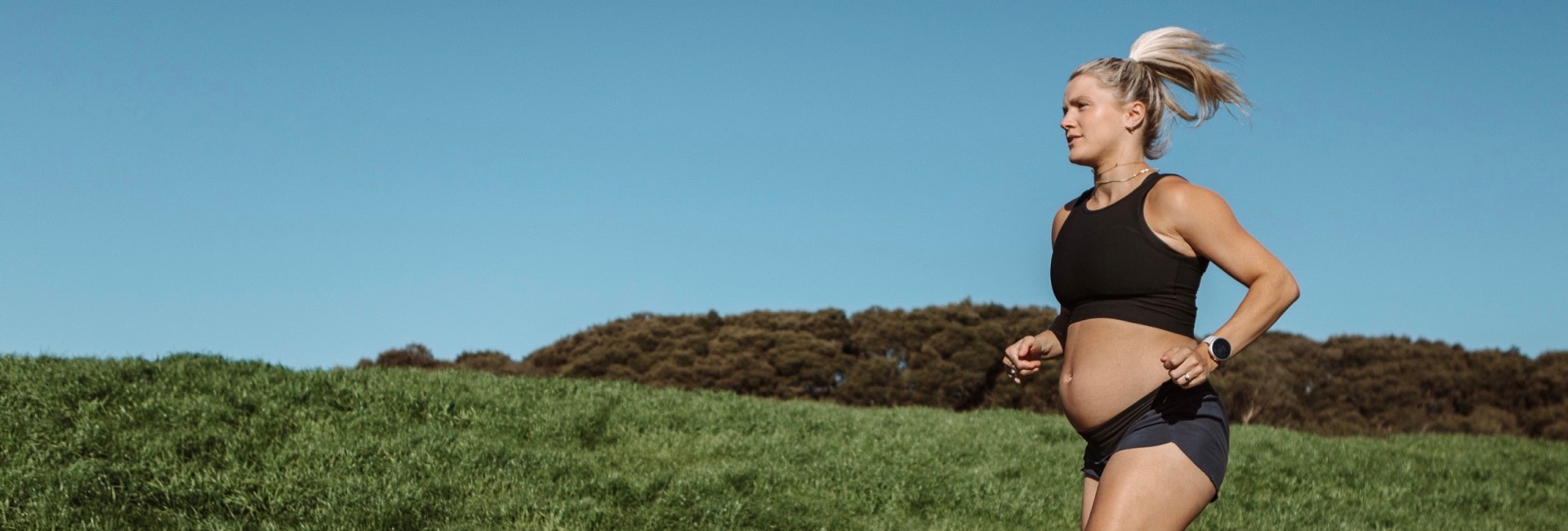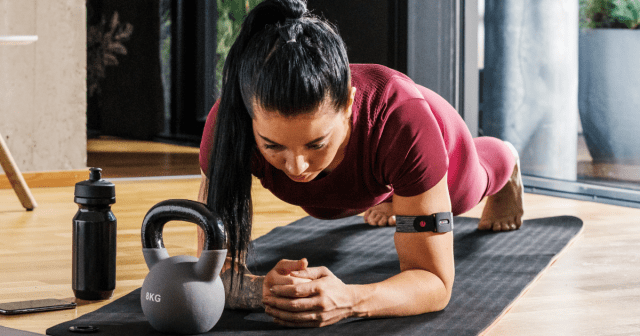The days of treating pregnancy as a type of illness are, thankfully, long gone. In fact, any advice given to avoid all forms of physical exertion or weight-bearing activities has been replaced with a positive attitude towards exercise during pregnancy. Staying active has proven to minimize common discomforts and contribute to a healthy labor.
As always, it’s wise to be careful about where you go for advice, as the internet can be a polarising vortex of misinformation on the specifics regarding weight training, running, and other forms of physical activity when pregnant. Even as a pre/post-natal specialist, I’ve experienced unsolicited advice and conflicting recommendations on how best to exercise when I became pregnant eight months ago.
With the understanding that many women experience confusion on safely working out during pregnancy, I hope this article will reassure, educate, and motivate you to stay active and continue enjoying the sweat life throughout each of your pregnancy trimesters.
Image credit: Sally Goodall
Is exercise safe during pregnancy?
It’s considered safe to exercise during pregnancy, provided there are no health contraindications, that your medical provider has given you the green tick of approval, and that your pregnancy is marked as low-risk.
Staying active while pregnant can help:
- boost your energy
- reduce the risk of gestational diabetes
- help maintain physical fitness
- bolster your mood
- improve sleep
- decrease postpartum recovery time
With such an extensive list of positives, it’s clear why so many women steer clear of a sedentary lifestyle during pregnancy in favor of one that’s active.
I caution that training intensity, exercise selection, and hydration are three key factors to monitor throughout each trimester when working with clients. Here’s why:
- Training intensity looks at heart rate and the level of perceived exertion (e.g. conducting the ‘talk test) to determine whether more rest is required during a workout and there’s a need to conserve more energy.
- Attention to exercise selection ensures the movements chosen for each workout safeguard the pelvic floor, consider the existing stretch of abdominal muscles and prevent any risk to the growing fetus.
- Lastly, adequate hydration during workouts ensures the body temperature remains cool (for both maternal + fetal temperatures), that there’s a healthy salt to electrolyte balance, and constipation is mitigated.
First-trimester pregnancy
While the baby bump is often less visible during the first trimester, a tremendous amount of change occurs within the body! There is a cocktail of hormones that is soaring internally, as well as blood volume changes happening. These can lead to increased fatigue, feelings of breathlessness, nausea, tender or swollen breasts, and frequent urination – certainly a bit different from the after-effects of a regular cocktail!
It’s not uncommon for many women to pull back on exercise during this trimester as the onset of fatigue and nausea can make workouts increasingly difficult, and for many, motivation dwindles. On the flip side, some women who weren’t previously active feel incentivized to kickstart a more physical lifestyle to be as healthy as possible for their baby. I would argue the latter is less common, but so long as you have no contraindications, it’s considered safe to start exercising, even if you weren’t an exercise-enthusiast prior to pregnancy.
Again, regardless of your previous training level, it’s always wise to seek counsel from your medical professional before starting a new exercise regime.
Exercise during the first trimester
If exercising is challenging during this time, or you’re unsure where to begin, I always encourage first-trimester women to master ‘the basics’. In this case, the basics can involve learning how to breathe efficiently through what’s termed ‘360-degree breathing’.
This diaphragmatic breathing pattern involves inhaling and exhaling through your front, back, and sides instead of belly-breathing or shallow breathing through your neck and shoulders.
As pregnancy progresses, abdominal muscles stretch, and many women complain of a tight upper back and neck. It is vital to avoid a tight neck and shoulders by learning to create back-body expansion by breathing into the thoracic (your upper/middle back).
Kegel exercises
Learning to relax the pelvic floor effectively is just as important as mastering the contraction!
During the first trimester, the other element to master is pelvic floor contractions, known as ‘Kegels’. Learning to relax the pelvic floor effectively is just as important as mastering the contraction! I’ve seen many women performing Kegels so often that they end up with a hypertonic pelvic floor – aka a pelvic floor with too much muscle tension or tone.
An excellent way to practice the relaxation and contraction of your pelvic floor involves connecting your breathing – inhaling and relaxing – down into your pelvic floor, and then on the exhale, lifting and contracting the pelvic floor. Mastering this pattern can be tricky at first, so never hesitate to reach out to a pre/post-natal exercise coach or a pelvic floor physio for guidance.
Second-trimester pregnancy
For many women, a new wave of energy appears like clockwork in the second trimester. However, if you’re already a seasoned athlete, it’s important not to mistake this energy boost as your green light to train at a high intensity.
As your baby bump grows during the second trimester, there are many new signs and symptoms to be aware of. Some of these include heartburn, constipation, lower abdomen aches, and mild swelling of the ankles and feet.
During this stage, abdominal muscles also begin to pull further apart. It becomes increasingly important to monitor for any abdominal coning – a Toblerone shape appearing through the centerline of your core. As your baby grows, it’s natural for your abdominal muscles to pull apart. Still, this coning indicates an intra-abdominal pressure management problem and means you should modify the exercise being performed.
It’s equally important to begin to monitor for pelvic floor heaviness or pain as the growing uterus starts to place more downward pressure on the pelvic floor. Utilizing your breath by exhaling during the ‘effort’ phase of an exercise can often help minimize downward pressure on the pelvic floor. An example is exhaling as you come to stand from a squat.
Second-trimester workouts
With pregnancy, there is a greater need to concentrate on our inner core muscles, which help stabilize the spine and assist our connection to the pelvic floor.
During the second trimester, I often challenge clients to reinterpret their traditional understanding of ‘ab work’. By replacing exercises that emphasize spinal flexion (e.g. crunches, sit-ups, Russian twists), you can instead focus on isometric or front-loading exercises that require little to no spinal flexion or twisting.
An easy way to understand your abdominal muscles is to picture them like an ‘ab-sandwich’ – they’re layered and can be divided into two segments of inner and outer muscles. The outer muscles (our six-pack muscles) are responsible for the movement of your trunk and are what we traditionally think of when we think of training our abs. However, with pregnancy, there is a greater need to concentrate on our inner core muscles (our transverse abdominis), which help stabilize the spine and assist our connection to the pelvic floor.
Provided there is no abdominal coning or pelvic floor pressure, side-planks, the Pallof press, modified push-ups, and half-kneeling overhead presses are some great ways to inadvertently work the core during this phase of pregnancy.
For many, the newly visible baby bump in the second trimester can also require a swap in equipment or adjusting exercises such as barbell hip thrusts in favor of bodyweight or banded hip thrusts to avoid the bar compressing the growing belly.
Third-trimester pregnancy

The final stretch of pregnancy! This time can be exciting (and nerve-racking) for many women, and it often requires a fair few training modifications from an exercise perspective. These changes are simply due to the rapid weight gain of the baby and the discomfort that can come from a growing mid-section.
Pregnancy exercises during third trimester
As the body’s center of mass changes, it becomes increasingly essential to err on the side of caution when it comes to single-leg or balancing exercises. Performing Bulgarian split squats or single-leg deadlifts close to a wall will increase stability and reduce the risk of falling.
The growing belly can also exacerbate postural changes. Many third-trimester women welcome mobility exercises that provide relief for the lower back, particularly if they tend to stand with an anterior pelvic tilt (which puts the lower spine in an exaggerated curve).
To help with this, perform pelvic tucks/tilts by lying on the floor with bent knees and practice pulling your belly button in toward your spine while pushing your pelvis up towards the ceiling. Rotating between a neutral pelvis and a posterior pelvic tilt (where the bottom of the pelvis rotates under the body) can help mobilize the hip and release lower back tension.
Symphysis pubis dysfunction and vena cava
Medical professionals caution exercising on your back for extended periods from the second trimester onwards due to the risk of the uterus pressing on the mother’s vena cava – which brings blood back to the heart from the lower body.
Ironically, as many women opt for wide-stance exercises during movements like squats, given the belly feels like it’s ‘in the way’, these wide-legged positions can exacerbate new pains such as symphysis pubis dysfunction (SPD/pelvic pain). I often advocate for fewer single-leg exercises, advise caution during wide-legged movements, and encourage smaller steps/strides when walking to minimize SPD pain.
Lastly, medical professionals caution exercising on your back for extended periods from the second trimester onwards (particularly in the third trimester) due to the risk of the uterus pressing on the mother’s vena cava – which brings blood back to the heart from the lower body.
While many find it difficult to interpret what quantifies an ‘extended period of time’, it can be easiest to add a small bolster or incline to supine exercises just to be safe – for example, performing bench press exercises at a 15-degree incline.
While there’s a need for greater education around exercising during pregnancy, remember that it’s possible to surround yourself with a strong support network of people who can inform and motivate you to stay active during this new exciting phase of your life.
Becoming pregnant isn’t a death sentence for your fitness; it’s simply a time where your workout intensity and exercise selection might need some tweaking. Embrace how your body changes for your growing baby and relish in the endorphins that come from working out during pregnancy!
If you liked this post, don’t forget to share so that others can find it, too.
Or give it a thumbs up!
I like this article
Please note that the information provided in the Polar Blog articles cannot replace individual advice from health professionals. Please consult your physician before starting a new fitness program.





